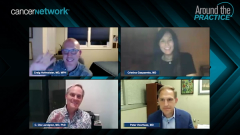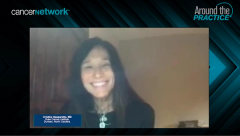
Challenges in Treating Transplant-Ineligible Multiple Myeloma
Shared insight on the difficulties of transplant-ineligible newly diagnosed multiple myeloma and how to optimally approach treatment.
Episodes in this series

Transcript:
C. Ola Landgren, MD, PhD:Welcome to this CancerNetwork® presentation: “Around the Practice: Optimizing First-Line Therapy in Transplant-Ineligible Multiple Myeloma.” I’m your host, Dr Ola Landgren. I’m a professor of medicine, and I’m the chief for the myeloma program and the experimental therapeutics program at the Sylvester Comprehensive Cancer Center at the University of Miami [in Florida]. Joining me are Dr Cristina Gasparetto from the Duke Cancer Institute [in Durham, North Carolina]; Dr Craig Hofmeister from Winship Cancer Institute of Emory University [in Atlanta, Georgia]; and Dr Peter Voorhees from Levine Cancer Institute of Atrium Health [in Charlotte, North Carolina]. Today we’re going to discuss strategies on optimizing for first line in transplant-ineligible patients with a diagnosis of multiple myeloma. We’re going to review 2 patient cases and involve you by using interactive online platform to answer several polling questions, and then we’ll discuss them in the panel.
We will now turn to some of the panel discussions. The first question I want to ask to the panel is, in general, what are some of the challenges in treating transplants-ineligible patients with multiple myeloma? Peter, do you have any feedback for the group?
Peter Voorhees, MD: The biggest challenge in treating transplant-ineligible patients is doing a really good job vetting whether the patient is transplant eligible. This is typically a frail-patient population, particularly those who are real-world transplant-ineligible patients, so the comorbidities that come to bear on treatment planning are important. Obviously, the morbidities they’re experiencing at the time of initial diagnosis. Those are the biggest challenges that we deal with for those patients.
C. Ola Landgren, MD, PhD: Cristina, what’s your take on the challenges of treating the transplant-ineligible patients? You’re focusing on transplants a lot. Are there any ineligible patients? If there are, what would be the challenges? What do you think?
Cristina Gasparetto, MD: I agree with Peter. Generally, the community physicians aren’t sending these patients to academia. They’re generally treated in the community, so we don’t see them often. One of the most important things is to choose the right treatment strategy so they can continue the durability of therapy. We never think much of the social support that these patients have. Can they come to clinic? Can they be followed routinely with the lab check? Do they have the social support so they can come to us to receive treatment? You have to take that into account as well, particularly for older patients. Can they travel? Can they drive themselves? Have they got caregiver support? Sometimes we forget about that.
C. Ola Landgren, MD, PhD: Craig, what do you see from your clinic?
Craig Hofmeister, MD, MPH: In addition to the comorbidities mentioned by the other panelist, the thing that gets me sometimes is communication. If you’re trying to reach out to my 40-year-old patient with myeloma, my 60-year-old patient with myeloma, and my 85-year-old patient with myeloma, you’re going to use multiple strategies to try to bring them in. That’s mostly humorous, right? One you can call, 1 you can text, 1 you can email, 1 uses Facebook, the other 1 has never seen Facebook. It’s different, and it’s an odd observation. But it has a true kernel in that my patients who are 85 years old often change quickly. In terms of tolerance and adverse effects, all of a sudden, it’s not that easy to get ahold of them, to bring them in, and to see them. As Cristina said, [they need] social support to get the resources to be able to tolerate things. Many times, my 82-year-old patient gets started on 4-drug initial therapy with 25-mg lenalidomide, and they get blown out of the water and immediately they’re stopped. All these drugs on the market have allergies. They’re moved to carfilzomib and dexamethasone alone. It’s crazy how sometimes the support and communication that seems a little easier in more fit patients is a struggle for patients.
C. Ola Landgren, MD, PhD:I’ll add some of my perspective. We’re all physicians specializing in myeloma, so we all have our own perspectives. My 2 cents is that I agree with everything the rest of you have said. What you bring up, Craig, is something that makes me think about giving very effective therapy for somebody who’s fit but a little older, so things can start going south faster. There’s more babysitting. You have to avoid a lot of things and stay on top, so you don’t run into unnecessary complications. There could be dangerous complications. Of course, all the other organ systems can start causing trouble as well.
Transcript edited for clarity.
Newsletter
Stay up to date on recent advances in the multidisciplinary approach to cancer.





















































































